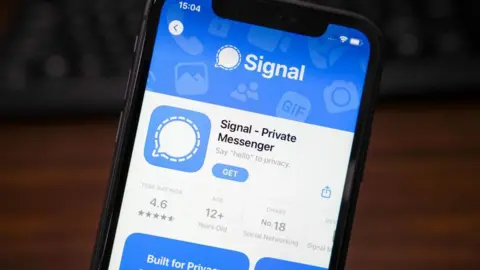### Understanding the Signal Messaging App and Its Security Features
In recent headlines, the Signal messaging app gained notoriety when it was revealed that it facilitated a private group chat among senior U.S. officials discussing sensitive military operations, such as a planned strike against the Houthi group in Yemen. This revelation sparked a wave of concern, particularly after the Atlantic’s editor-in-chief, Jeffrey Goldberg, was inadvertently included in this chat, leading to significant backlash and calls for investigations, notably from Senate Majority Leader Chuck Schumer.
So, what exactly is Signal, and how secure are its communications, especially in high-stakes situations involving national security?
### What is Signal?
Signal is a free messaging application that has garnered between 40 to 70 million active monthly users. While this user base is minimal compared to giants like WhatsApp and Facebook Messenger—which have billions of users—Signal is highly regarded for its robust security protocols. At the core of its protective measures is end-to-end encryption (E2EE), which ensures that only the individuals involved in a conversation can read the messages. Not even Signal intercepts or stores these communications, an aspect that makes it appealing for privacy-conscious users.
### Advanced Security Features of Signal
Signal’s security features extend beyond standard encryption. Unlike many other apps that employ E2EE (like WhatsApp), Signal’s codebase is open-source. This transparency allows others to examine the application for potential vulnerabilities that could be exploited by hackers. The Signal Foundation, which owns the app, operates as a non-profit organization that relies on donations rather than advertising revenue and, thus, can maintain strict privacy standards without compromising user data for financial gain. As Signal’s leader, Meredith Whittaker, noted after the recent news cycle regarding U.S. national security, it serves as the benchmark for private communications.
### Limitations of Signal’s Security
However, despite its advanced security measures, cybersecurity experts recognize that such safeguards may still fall short in scenarios involving highly classified national security discussions. As noted by data expert Caro Robson, using Signal for these discussions is “very, very unusual.” High-ranking officials typically utilize secure government platforms, which are developed and supervised with superior levels of encryption tailored for critical communications. In the U.S., sensitive compartmented information facilities (SCIFs) are generally employed for discussing classified matters. These facilities are controlled environments where personal electronic devices are prohibited, and conversations take place under strict safety protocols.
A SCIF is notably designed to minimize risks, requiring security measures such as regular sweeps for listening devices and specialized equipment secured using the government’s highest encryption standards.
### Privacy and Record-Holding Concerns
Signal also includes a feature that allows messages to disappear after a set period, generating further discussion regarding record-keeping compliance. For example, the messages in the Signal group chat that included Goldberg began to vanish after one week. This could lead to potential violations pertaining to required record-keeping, especially if communicators did not transfer those messages to secure government accounts. Additionally, while the end-to-end encryption ensures confidentiality, sharing sensitive data with the wrong recipient can render even the most advanced security provisions moot.
This reality poses the question of how secure any messaging app can truly be when the primary asset is compromised through user error. As one critic bluntly pointed out, “Encryption can’t protect you from stupidity.”
### Broader Implications for Secure Messaging
The controversy surrounding Signal illustrates a crucial balance between security and usability in modern messaging applications. While messages can be well encrypted and secure, the ultimate protection lies not just in the application itself but also in the vigilance and practices of its users.
Overall, Signal remains a vital tool in the landscape of secure communication. Its strengths lie in its commitment to privacy, transparency in its operations, and advanced security mechanisms. However, the events surrounding its use among U.S. officials serve as a reminder of the inherent vulnerabilities in any communication system.



